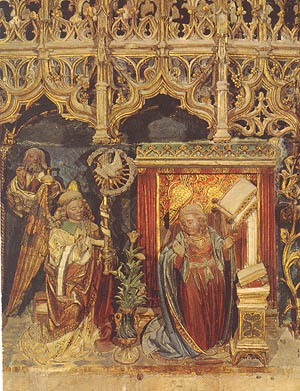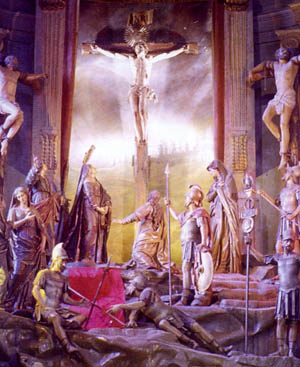 |
Feast Days of Our Lady
Our Lady of the Rosary – October 7
Prof. Plinio Corrêa de Oliveira
The feast day of Our Lady of the Rosary was instituted by St. Pius V in commemoration of the victory of the Battle of Lepanto on October 7, 1571 against the Turks who were threatening Europe. In 1716, the feast was extended to the entire Church in thanksgiving for the defeat of the Muslim Crescent in Hungary.

Santa Maria La Mayor,
patroness of the city of Burgos, Spain |
The devotion of the rosary was revealed to St. Dominic by Our Lady. It was born, therefore, in a private revelation. And we know that such revelations are abhorred by the enemies of the Church – internal and external. Although it came from a private revelation, the praying of the Rosary was extended to the entire Catholic Church, and was considered by St. Louis Grignion de Montfort as the characteristic devotion of predestined souls.
Before Vatican II, the habits of many religious Orders had rosaries that hung on their cinctures, and good Catholics used to carry the rosary with them all day. It was considered not only an item for counting the Hail Marys, but a blessed object, the seal of a special liaison of the person with Our Lady. Many times, the mere physical presence of the rosary would repel the Devil and attract special graces. It became the classic religious object to fight against the Devil.
What is the rosary? The rosary is a series of mediations on the mysteries from the lives of Our Lord and Our Lady. These mysteries are simultaneously prayers that one says vocally and meditations that one makes mentally. This mixture of vocal prayer and meditation is a splendid thing, because while the lips pronounce a plea, the mind concentrates on a point of the mystery. It is a dual activity that intimately unites one with God.
The practice of praying the rosary to beg a grace from God supposes the theological truth that Our Lady is the Universal Mediatrix of all graces. It is, therefore, a small masterpiece of spirituality and Catholic doctrine as they should be understood. The rosary is not a religious custom relying on emotions, but rather a serious, solid, and meditative pious practice, which explains why the rosary has obtained so many graces.

Each mystery of the Rosary has its special graces that correspond to the meditation. Above, the Annunciation in the Monastery of El Paular, Madrid. Below, the Crucifixion in the Bom Jesus Sanctuary in Braga, Portugal
 |
It is very beautiful and valuable to meditate on the mysteries of the rosary, because for each decade, one contemplates a different thing with its special graces: There are particular graces for the mystery of the Annunciation, others for the Agony in the Garden, yet others associated with the Ascension of Our Lord. Each one of the decades has its special graces, and the person who meditates on all of them attracts to his soul the ensemble of graces from the lives of Our Lord and Our Lady. It is a complete circumnavigation that brings a supernatural plenitude to the soul of the person, which helps us to better understand the salutary influence of the rosary.
A Catholic, thinking and reflecting on things of the Faith, should draw conclusions that build upon each other and constitute a kind of architectural construct. This should be the spiritual life of a Catholic. It follows in accordance with the way God governs the universe. He wisely judges the weight and measure of everything. This is another reason why the rosary is an excellent devotion.
We know that the victory of the Battle of Lepanto was achieved when St. Pius V interrupted a meeting with Cardinals at the Vatican and went to a window and started to pray the rosary. He was deeply concerned about the future of the Church and Christendom that was being decided in those Mediterranean waters. After the Pontiff finished praying the rosary, he returned to the meeting and told the Cardinals that the Catholic fleet had been victorious. That is, he had a revelation while he was praying the rosary. It was the way Our Lady showed him that she linked that victory to his praying of the rosary. Understanding this, St. Pius V instituted the feast of Our Lady of the Rosary, which was extended to the whole Church in commemoration for another great victory over the Mohammedans in 1716.
The fact that this devotion is specially linked to victories over the enemies of the Church and Christendom induces us to think that it will protect all those who fight against the enemies of the Catholic cause. It is a devotion that most probably will endure until the end time, when the enemies of the Church will be more dangerous than ever.
Therefore, also during the chastisement predicted at Fatima, the assiduous recitation of the holy rosary should be a decisive factor of victory for those who would be defending the Catholic cause. The historical antecedents of the value of the rosary are a pledge of analogous future victories.
When St. Alphonsus of Liguori was already old, sick, and in a wheelchair, a lay brother used to wheel him around the cloister of his monastery in the evening so he could take some fresh air. Engaging the brother in conversation, St. Alphonsus asked him:
“Did you pray your rosary today?”
“I don’t remember,” the brother answered,
“Then, let us pray it now,” the Saint said.
“But you are already so tired. What difference does it make if we don’t pray the rosary for one day?” protested the brother.
St. Alphonsus answered: “If I did not pray my rosary for even one day, I would fear for my eternal salvation.”
This is what a Saint said. I like this episode because it teaches us that we should do precisely the same. The daily rosary is a great guarantee of final perseverance and fidelity for the times ahead when the prophecies of Fatima will be fulfilled. The victory in our everyday Lepanto is linked to the recitation of the rosary.
Let us ask Our Lady of the Rosary to bless this intention of saying the Rosary daily and give us the grace to carry it out.


  | | Prof. Plinio Corrêa de Oliveira | |
The Saint of the Day features highlights from the lives of saints based on comments made by the late Prof. Plinio Corrêa de Oliveira. Following the example of St. John Bosco who used to make similar talks for the boys of his College, each evening it was Prof. Plinio’s custom to make a short commentary on the lives of the next day’s saint in a meeting for youth in order to encourage them in the practice of virtue and love for the Catholic Church. TIA thought that its readers could profit from these valuable commentaries.
The texts of both the biographical data and the comments come from personal notes taken by Atila S. Guimarães from 1964 to 1995. Given the fact that the source is a personal notebook, it is possible that at times the biographic notes transcribed here will not rigorously follow the original text read by Prof. Plinio. The commentaries have also been adapted and translated for TIA’s site.
|
Saint of the Day | Home | Books | CDs | Search | Contact Us | Donate

© 2002- Tradition in Action, Inc. All Rights Reserved
|
 |

|